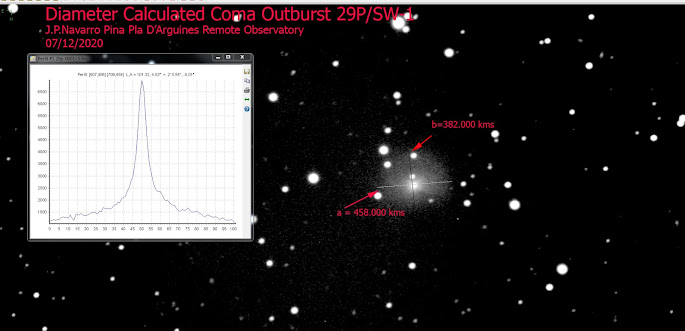Tuesday, December 8, 2020
Monday, October 26, 2020
249 P/COMET JFC
Hello everyone, I just obtained this image of comet 249 P / LINEAR, with magnitude m1 = 20.0, through the Pla D'Arguines Remote Observatory (Segorbe, Spain) MPC 941.
The Comet 249 P / LINEAR, the reflectance spectrum of 249P is similar to that of type B asteroids.
The total dust mass expelled during its last passage through perihelion was (2.5 ± 0.9) × 10 ^ 8 kg, a nuclear radius of between 1 and 1.3 km is assumed.
0249P KC2020 10 25.12838 07 02 09.97 +19 21 01.2 20.0 N 941
https://www.facebook.com/groups/471844886224484/
Requires having a facebook profile and approval as a member of the group.
Regards, J.P. Navarro Pina
Administrator Comet Asteroid Meteor Watch Fb-Group.
Sunday, August 16, 2020
Search Correlation rotation period versus diameter C/2020 F3 NEOWISE .
ATEL #13945 ATEL #13945
Title: Rotation of Comet C/2020 F3 (NEOWISE)
Author: Michal Drahus (Jagiellonian University in Krakow), Piotr Guzik
(Jagiellonian University in Krakow), Andrew Stephens (Gemini Observatory),
Steve B. Howell (NASA Ames Research Center), Stanislaw Zola (Jagiellonian
University in Krakow), Mikolaj Sabat (Jagiellonian University in Krakow),
Daniel E. Reichart (University of North Carolina at Chapel Hill)The observed morphological evolution implies a rotation period of 7.58 +/- 0.03 hr with no obvious temporal changes or deviations from a simple rotation state over the reported time interval. This result is consistent with an earlier value of 7.5 +/- 2.3 hr reported by Masi 2020 (CBET 4816).
I decided to establish a correlation period of rotation - diameter of the nucleus, it is known that the greater the diameter the rotation of the comet nucleus is slower, and the smaller the diameter the rotation is faster, the average rotation period of many comets is approximately about 15 hours, based on Whipple's work.
In the case of comet C / 2020 F3 NEOWISE the P (rot) = 7.5 hours, analyzing other comets such as 6 P / D'Arrest, P (rot) = 7.2 h (Lowry, Weissman 2007), and a D (km) = 1.6 km (Ferrin 2009), results in a nuclear radius of Rn = 0.8 kms, another comet similar in the period of rotation to F3 NEOWISE is comet 46 P / Wirtanen, with D (km) = 0.9 kms (Fink V. et at. 1997), with a P (rot) = 7.6 h (Ferrin 2009), looking for articles with references, the most interesting is that of Sosa / Fernandez, who establish the following equation 1.0:
log D (km) = 1.5 - 0.13 * H ........... (Sosa & Fdez)
Checking this formula 1.0 I applied it to the previous results, and it was not a good fit, so I decided to apply a new personal adjustment, which is the following 1.1:
log D (km) = 1.3 - 0.13 * H ............... (Navarro)
finding a comet diameter of 0.94 kms, a value that is more in line with reality.
Another new formula that relates the activity index with the gas production rates is the following 1.2:
log Q (C2) / log Q (H2O) = - n ............... (Navarro)
Coefficient of variation of the rate of increase in brightness 1.3:
K = d (n) / d (r)
r heliocentric distance
n rate of increase in brightnes
Friday, August 7, 2020
Update Light Visual Curve C/2020 F3 NEOWISE
Friday, July 10, 2020
Light Visual Curve C/2020 F3 NEOWISE

Friday, May 8, 2020
Analysis C/2020 F8 SWAN

Friday, April 24, 2020
Evolution of the fragmentation of the comet ATLAS from April 20 to 23, 2020 based HST images .

Wednesday, April 22, 2020
C/2019 Y4 ATLAS HST
Friday, April 17, 2020
Tuesday, April 14, 2020
Friday, March 27, 2020
Light visual curve comet C/2019 Y4 ATLAS ( News )

Sunday, March 22, 2020
Light Visual CCD Curve Analysis of the comet C/2019 Y4 ATLAS
NUCLEAR ABSOLUTE MAGNITUDE vs NUCLEAR RADIO COMETS FOR 38
In the case of applying this equation to comet 12P/Pons-Brooks, a Nuclear Radius of 2.84 km is obtained, which corresponds to a core diamete...

-
The new estimated nuclear radius of the comet is RN = 0.75 +/- 0.02 kms. The active area fraction of the core surface is (F)+/-o= 1.4+/- 0.0...
-
After a last update of the light curve of Comet Leonard, and using only visual observations, it seems that, if there are no surprises, the ...












